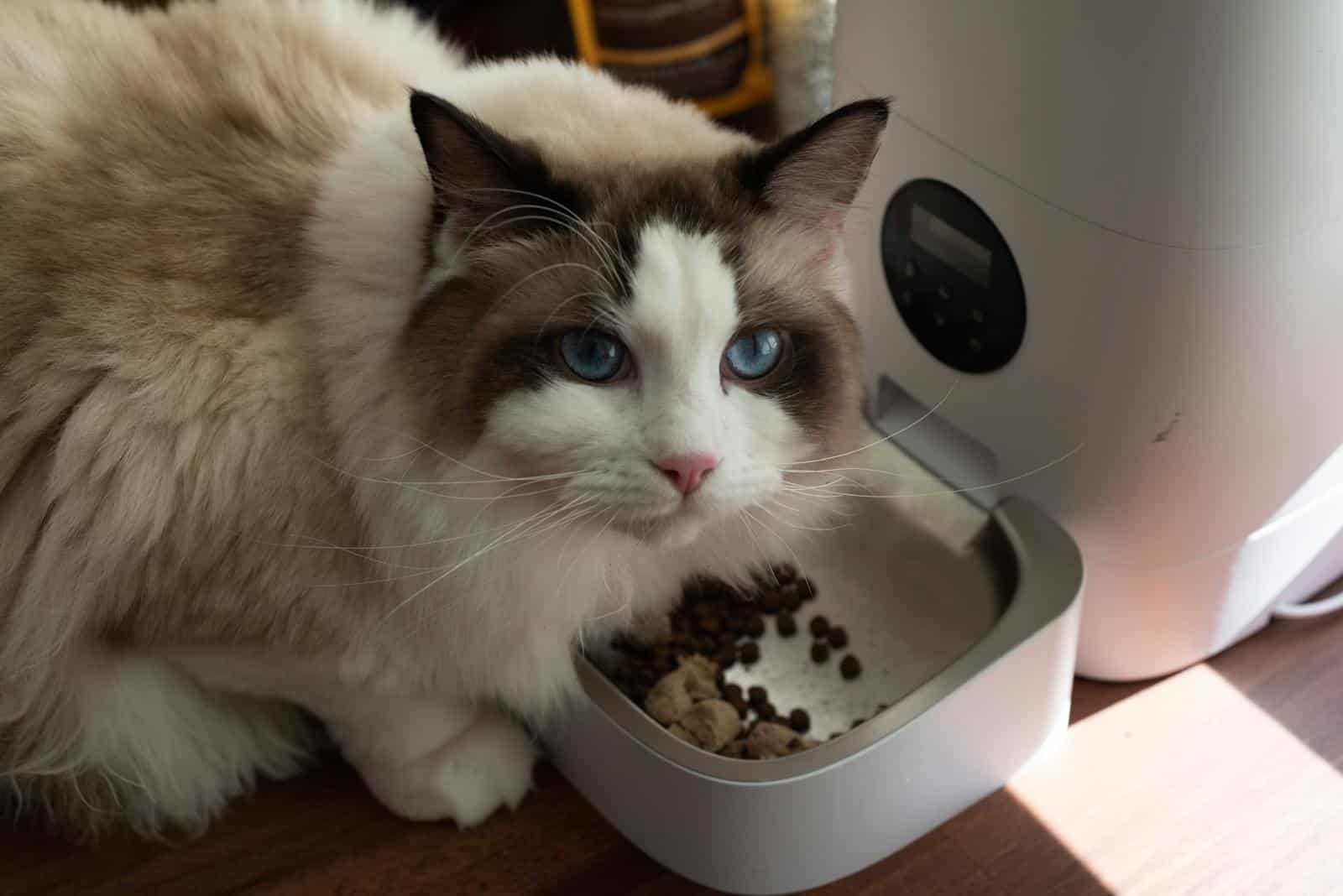I’ve been caring for pets in Virginia and Maryland for over 15 years, and I can’t tell you how many times pet parents have asked me about automatic pet feeders. While these modern design gadgets promise convenience and perfect portions, the reality is far more complicated. After seeing countless pets struggle with these devices—and cleaning up the messes they create—I want to share why I believe automatic feeders aren’t suitable for our beloved companions.
Don’t get me wrong—I understand the appeal. You’re juggling work, family, and a million other responsibilities. The idea of a device that handles feeding while you’re stuck in traffic or working late sounds like a dream come true. But after years of walking dogs whose automatic feeders have malfunctioned and caring for cats who’ve developed anxiety around these machines, I’ve learned that convenience often comes at a steep price.
Let me walk you through the ten biggest problems I’ve encountered with automatic pet feeders so you can make an informed decision about what’s truly best for your furry family member.

Photo by Matthew Henry on Unsplash
1. Technology Fails When You Need It Most
Nothing breaks my heart more than arriving at a client’s home to find their pet hasn’t eaten because their automatic pet feeder decided to have a power outage meltdown. These devices rely heavily on technology—from LCD screens to app connectivity—and when that technology fails, your pet suffers.
I’ve seen feeders that stopped working because of a simple WiFi hiccup, leaving pets hungry for hours. Even feeders with dual power supplies can fail if both the electricity goes out and the backup batteries are dead. Your pet doesn’t understand why their food isn’t coming, and they can’t exactly call tech support.
The worst part? These failures often happen at the most inconvenient times—during storms, extended workdays, or when you’re traveling. At Kate’s K9 Pet Care, we’ve had emergency calls from panicked pet parents whose automatic feeders stopped dispensing food right when they needed them most.
2. No Personal Touch or Bonding Time
Feeding time isn’t just about nutrition—it’s one of the most important bonding moments between you and your pet. When I do overnight care for clients, I always make mealtime special. I talk to their pets, give them attention, and use the opportunity to check on their overall health and mood.
Automatic Cat Feeder
An automatic cat feeder or pet feeder eliminates this precious interaction. Your pet misses out on the emotional connection that comes with shared mealtimes, and you lose the chance to observe important changes in their eating habits, energy levels, or behavior.
Small dogs especially benefit from the social aspect of eating. They’re pack animals who naturally want to share meals with their family. Replacing that connection with a cold machine can leave them feeling isolated and anxious.
3. No perfect Portions | Portion Control Problems
While manufacturers promise “perfect portions,” I’ve witnessed countless portion size failures with automatic feeders. The dispensing mechanism can get clogged with kibble, causing either no food to come out or way too much food to dump into the bowl at once.
I once arrived at a client’s house to find their cat had received several days’ worth of food in a single serving because the feeder mechanism jammed and then released everything at once. The poor kitty had overeaten and was feeling sick, while the owners returned from their trip thinking everything had gone smoothly.
Fresh food and dry food have different dispensing requirements, and many feeders struggle with variations in kibble size and shape. What works perfectly during setup might fail miserably with a different brand of food.
4. Cleaning and Maintenance Nightmares (Even Stainless Steel Bowl Feeders)
Despite claims of easy cleaning, automatic feeders are surprisingly high-maintenance. The internal mechanisms collect food dust, oils, and debris that can harbor bacteria and create unpleasant odors. Even feeders with stainless steel bowls require regular deep cleaning of the dispensing parts.
I’ve seen feeders that hadn’t been properly cleaned develop mold inside the food storage area—something that’s not immediately visible to pet parents but can make their pets seriously ill. The complex internal mechanisms make thorough cleaning difficult and time-consuming.
Many pet parents think they just need to wipe down the bowl and refill the food, but proper maintenance requires disassembling parts, cleaning internal mechanisms, and ensuring everything is completely dry before reassembly.
5. Limited to Dry Food Only
Most automatic feeders only work with dry kibble, which severely limits what your pet eats. If your pet requires wet food for health reasons, has dental issues that make dry food difficult to eat, or simply prefers variety in their diet, automatic feeders become useless.
Cats, in particular, often need wet food to maintain proper hydration, especially if they don’t drink enough water. Many senior pets or those with health conditions require specialized diets that can’t be dispensed through an automatic feeder.
This limitation becomes especially problematic when you’re trying to transition your pet to a new food or when they need medication mixed with their meals—something I help clients with regularly during my visits.
6. Creates Feeding Anxiety and Behavioral Issues
I’ve observed that many pets develop anxiety around automatic feeders. The mechanical sounds, unpredictable timing (when the device malfunctions), and lack of human presence and feeding schedule can stress sensitive animals.
Some pets become obsessive about the feeder, sitting and staring at it for hours, waiting for food to dispense. Others develop fear responses to the mechanical noises and may avoid eating altogether. This is especially common with rescue animals who already have trust issues.
Cats are particularly sensitive to routine changes and mechanical noises. I’ve seen cats who stopped eating entirely when their owners switched to automatic feeders, requiring intervention to get them back to healthy eating habits.
7. Multiple Pet Household Disasters
If you have more than one pet, auto feeders can create serious problems. There’s no way to ensure each pet gets their fair share—or their specific dietary requirements. The more assertive animal often eats everything while the shy one goes hungry.
During my visits to multi-pet households, I always supervise feeding to ensure each animal gets their proper portion and any necessary medications. An automatic feeder can’t distinguish between pets or prevent food guarding behaviors.
I’ve seen situations where one dog learned to trigger the feeder repeatedly, leading to overeating and food aggression issues. Meanwhile, the other pets in the household became increasingly anxious about getting their meals.
8. Expensive Upfront and Ongoing Costs For Automatic Feeders With A Modern Design
Quality automatic feeders with modern design and reliable features cost significantly more than regular feeding bowls. When you factor in replacement parts, specialized food storage pouches, and the inevitable need to replace the entire unit when it breaks, the costs add up quickly.
Many pet parents don’t realize they’ll need to purchase specific accessories like food-saver pouches or replacement parts. Some feeders require proprietary components that are expensive and may not be available if the company stops making them.
Compare this to the cost of having a professional pet sitter provide personalized feeding—along with companionship, exercise, and health monitoring—and the value equation often favors professional care.
9. No Health Monitoring or Emergency Response
One of the most important aspects of my job is monitoring pets for health changes. During feeding time, I watch for changes in appetite, eating speed, difficulty chewing, or signs of illness. An automatic feeder can’t do any of this.
If your pet becomes ill, injured, or has an emergency while you’re away, an automatic feeder keeps dispensing food as programmed, potentially making the situation worse. I’ve arrived at homes where pets were clearly unwell but had continued to receive regular meals, masking important symptoms.
Elderly pets or those with health conditions particularly need human observation during meals. Changes in eating habits are often the first sign of serious health problems.
10. False Sense of Security
Perhaps the biggest problem with automatic feeders is that they give pet parents a false sense of security. You might think your pet is completely cared for, but feeding is just one small part of your pet’s daily needs.
Pets need companionship, exercise, mental stimulation, and health monitoring—none of which an automatic feeder provides. I’ve seen too many pets become depressed and develop behavioral problems when left alone for extended periods, even with regular automatic feeding.
At Kate’s K9 Pet Care, we provide updates, photos, and notes after every visit because we know how much pet parents worry. An automatic feeder can’t send you a photo of your happy, healthy pet or alert you to potential problems.
A Better Solution Than Automatic Feeders: Professional Pet Care
Instead of relying on automatic feeders, consider the peace of mind that comes with professional pet care. When you choose Kate’s K9 Pet Care, your pet receives personalized attention, proper portion control, and health monitoring—all while maintaining their important routine and social connections.
Our experienced team provides feeding services along with companionship, exercise, and the loving attention your pet deserves. We’re licensed, bonded, and insured, with over 15 years of experience caring for pets throughout Virginia and Maryland.
Peace of Mind Starts Here — Reserve Service Today. Your pet deserves more than an automatic feeder can provide. They deserve the personalized, professional care that keeps them happy, healthy, and loved while you’re away. Schedule Your Free First Walk Now and discover the difference professional pet care makes.







